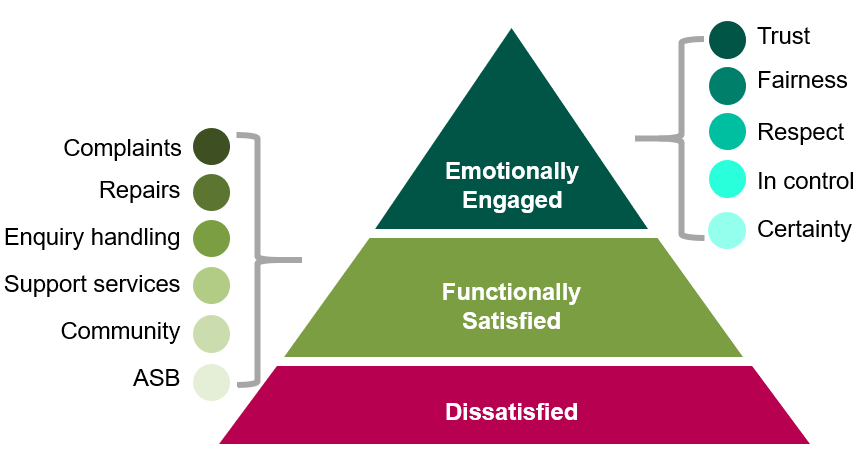
Complaints are important sources of customer feedback and can be used to direct improvements that increase customer satisfaction overall — but when handled poorly, can create bad feelings and mistrust. How can you improve satisfaction with complaints, mine the wealth of customer and colleague intelligence, smooth and enhance your complaints process, and improve performance?
We’ll take you step-by-step through our complaints two-way customer journey mapping process to show you how to do it.
Why is customer journey mapping complaints important?
Understanding customer complaints and having a robust complaints handling process is essential. First, we need step back and look at where complaints handling sits in the bigger picture of customer service. We know there’s scrutiny on complaints and how they’re handled, in terms of outcomes and operational performance. Internally, things can become desensitised as organisations prioritise complaints volume, complaints closure rates or complaints handling duration based on departmental metrics. Putting yourself in the customer’s shoes and understanding the emotional importance of the complaint can sometimes be lost in the push for high performance.
Organisations focused on emotional connections fare better
There is a lot of research and evidence supporting this emotionally engaged status (see graphic below). In a commercial world, this leads to greater loyalty and profitability, and for non-profit organisations, there are operational gains— with reduced levels of complaints, and more willingness to work with organisations to resolve issues, customers are more likely to forgive or give leeway if things do go wrong.

Looking at this pyramid approach, the bottom level encapsulates dissatisfied, disgruntled customers. Customers who are satisfied with transactions sit in the middle layer. But what we want to see is residents who are emotionally engaged with us at the top of the pyramid.
Factoring in emotional engagement
Emotional engagement is more than just dealing with issues in 10 days. It’s also how you speak to residents as they progress through a service, and how you respect the resident relationship through your actions and communications. You may be doing well in terms of meeting your deadlines or hitting your targets, but we need to make sure that there are some emotional factors being considered, as residents want trust, fairness, and respect.
Residents want to feel as if they have some control over their experience with an organisation. This will not necessarily mean that everything is fixed, but that your customers know what will happen next and when it’s happening. It’s not always easy to keep residents in the emotionally engaged stage of your customer journey, but it is even more difficult when you’re responsible for a service and they have lost trust because something went wrong.
The impact of Covid
When Covid hit, there was a surge in proactive communications with tenants to check up on their wellbeing. Several housing providers that we work with saw that satisfaction levels improved when they switched over to this more emotional form of contact. Trust and transparency are key drivers of overall satisfaction, so there’s evidence there that once you switch to softer servicing skills, it affects the overall satisfaction as well.
Complaints are an opportunity to create advocates
When we are focusing on a good customer experience and complaints are being handled well, these customers can become your biggest advocates. There’s a real potential to engage with these customers, who then champion your service. They know that if they come to you with a complaint, you handle it well and treat them with fairness, they will go on to advocate for you.
When we hold focus groups with customers, we often ask residents at the beginning to think about a really great customer experience – what does that look like to them and how they experienced it. And nine times out of 10 these experiences start with a complaint! Something went wrong, but the way it was handled is viewed as an example of a great customer experience.
Sometimes advocacy is born out of mistakes. When they inevitably do happen, it’s about recognising that you’ve got this potential group of advocates, if you treat them with fairness and respect
The concept of “fair exchange” during the customer journey
It’s important to maintain fairness in the balance of customer effort. When a customer feels like they are putting in more effort than the landlord to resolve the issue, it’s seen as an unfair exchange. Ultimately, when something has gone wrong with a resident’s experience of your organisation, it’ll show in their willingness to work with you or respond positively to any communication.
There’s evidence that customers who feel like they’ve had to put more effort in are four times more likely to churn, three times more likely to share the negative experiences on social media and twice as likely to tell friends and family about that bad experience.
Three steps for customer journey mapping your complaints service: Establish, Evolve, Evaluate
1. Establish where you are, and what is known
When you are bringing a customer journey into focus, then you have likely done some mapping and bridged the gap between the customer experience and operational processes. This assessment will be important to consider when it comes to complaints because they form a core pillar of your complaint process review.
Identify the pain points and successes where you know things are going well. You’ll want to undertake some desk research looking at operational data, and customer feedback data you’ve received through any channels. It’s important to talk to colleagues as well to find out what they think works and doesn’t work about the process.
When a service is very process driven (like complaints) it’s easy to forget there’s a customer who’s quite anxious or looking for a resolution at the end of the complaints journey. You want to review what is going on underneath the surface of the processes at this stage to understand the level of emotional engagement as well.

These are the general customer touch points we’re considering. The level of detail you need should be granular enough to account for all possibilities from your process.
2. Evolve your processes and pain points
During the Evolve stage, review all customer journey touchpoints, and capture key areas of success and failure in your complaints data. Address how you will communicate this information to customers within your organisation internally as well as externally.
Internal communications mean getting staff on board with the strategy, so you’ll need to work with your employees to outline the benefits for themselves as well as customers. Colleagues will understand how these changes will improve their working life with these new improved processes or practices.
Communication is essential
Communicating information about changes to customers is important as it shows that you’ve listened and are taking action. You are reinforcing and confirming that you’ve heard what residents have said, and how you are responding.
We recommend our clients to adopt the new active voice of “you said, we are doing” rather than “you said, we did” because it’s good to get residents on board, telling them what’s in progress but also what you are actively doing in relation to their feedback and inviting further engagement.
3. Evaluate with a critical eye
Finally, the Evaluate stage is about putting something into practice to future proof and monitor how you’re doing. You need to determine whether your changes have worked, learning from the experience, and adjusting to make sure that you’re sharing successes as they come back through in client feedback. Colleagues will want to see the resident feedback improving and see how the new processes are working and their efforts have been recognised. It’s also great for customers to see how the business is changing and that their voice matters – when something is important to a resident, it’s important to you. It’s a great story to share back with your residents.
The methodology matters
When we map complaints or transactional customer journeys, the methodology will consist of depth interviews with residents, and carrying out focus groups with colleagues. Your approach often determines your outcomes, and we find this mixed method is most effective.
Resident depth interviews
Ideally, we conduct in-depth interviews with residents for the complaints process because it is typically a sensitive subject. We can walk someone through all the steps of their customer journey to understand exactly what has happened. We want to gain a better understanding of what the customer wants for their ideal journey. We also break down how individuals feel about their service at each point in the process to see what worked and what could be improved. This links the understanding of satisfaction with the more enhanced level of emotional attachment, and alongside that, trust, and transparency.
Colleague workshops
To get internal feedback on the complaints process, we conduct focus groups with employees to discuss their thoughts on the issues with the current processes and what might need to change. Employees often have great ideas for improvement that you might not be aware of, because they typically just do their job without thinking about what others go through in accomplishing tasks. One key problem is that your colleagues are often focused in their particular expertise, without a forum to put all these individual pieces of information together. Workshops are important to bring everyone together and discuss how the complaints process works, with the goal of improving your customer journey.
Designing a customer journey that works for everyone
The complaints customer journey will be redesigned from the evidence that we’ve gained through the data gathered, and from interviews and workshops. It’s important that we have the granular input of every single touch point from customers and your colleagues, and then use that level of detail when redesigning and improving the complaints process, keeping the things that work, and challenging those steps where pain points exist.
Embedding the new changes with feedback loops
Embedding these changes in a lasting way is really important and takes time to do well. The communication around embedding those changes is critical as staff need to be on board from the start. We’ve found that staff workshops can be beneficial because you are drawing directly on expertise from your employees and they in turn feed into the redesign. It’s a nice way of improving the process as well as engaging them in the change process itself. You are ultimately making sure staff are equipped with all the tools, training, and confidence they need to put these changes into practice. Workshops reinforce how important their role is and when you get feedback about complaints, it’s often about how your residents were spoken to, or the communication throughout. They will see that they do have a direct influence on how the customer feels about your organisation.
Keeping customers and colleagues in the loop
Perception surveys
It can take some time to embed these changes into an organisation, so it’s important that you have communication with customers and colleagues throughout the process. Once you have your new journey touch points, and you have new and improved processes in place, what’s really important is making sure that you have a mechanism to get feedback in terms of how that’s working. Perception surveys are an effective way to monitor and track trends in the overall relationship. They are also important to comply with the principles set out in the Social Housing White Paper in terms of informal expressions of dissatisfaction. Remember, it’s important that we’re not just focusing on formal complaints but expressions of dissatisfaction. Perception surveys are a really good way to identify residents and potentially intervene when customers are unhappy but haven’t necessarily gone down the formal complaints route.

Transactional surveys
Transactional surveys give you that diagnostic real time feedback in terms of the specific complaints journey, at the point of closing the case (or if it’s a longer case perhaps a midpoint check in). The surveys are designed so that once the resident has experienced the customer journey, you receive the feedback in real-time. Residents can tell you what is and isn’t working, and you’ve got a closed loop feedback function built in as well. You can also escalate issues and get back to customers if there has been an issue and intervene at an earlier point in time.
When you treat your customers in a respectful, fair way, and resolve their complaints as quickly as possible with the right amount of effort, they may be more likely to turn into advocates for your organisation.
Saying “sorry” is a good thing
When looking at interventions, we need to understand that it’s really OK to say “Sorry”. Sometimes there’s a worry about apologising, implying that you’ve done something wrong, but, sometimes sorry is enough for customers and it’s what they need to hear.
“I’ve worked on depth interviews asking customers about how they would like to have their issue to be resolved. Over half of the residents I interviewed mentioned “to be treated with respect through the process” or “receiving a nice, detailed explanation; being kept informed,” and others said that “a simple apology” was really all they wanted. Sometimes it’s okay to say sorry, and I think that’s the human part of the complaint process that is sometimes lacking.”
Laura Fuller, Director, IFF
Emotional engagement driving satisfaction
Complaints journey mapping helps organisations go from mere satisfaction with the transaction, to high emotional engagement while experiencing and using your services. Recognising that you have performance metrics that you have to achieve, is fair enough when you are a regulated, registered provider of social housing, but we can’t forget there’s an emotional connection that is necessary for customer relationships. That’s why it’s important to have greater trust, transparency, and emotional metrics in your feedback programme.
Interested to learn more?
Our housing experts are here to help you. If you are interested in mapping your complaints customer journey, our housing specialists will share the most recent best practice to your team, and make a real difference to your process. Get in touch with our housing sector team for a brief chat about your requirements.